Choosing sustainable products has been on the rise for years now. Many shoppers have made organic foods, eco-friendly clothing, and natural household cleaners part of their everyday lives. But what about bedding? The products that we sleep on should be held to the same standard, yet so many brands use unsustainable processes and materials. But our bedding is made different—with sustainable, 100% organic cotton that feels naturally soft and luxurious. We never use toxins or harsh chemicals, which pose a threat to both the people and the planet.
We prioritize transparency at every step, using a supply chain that we created from scratch. Since the very beginning, we’ve been partnering with trusted suppliers to make sure our products are good for you, good for the environment, and good for the people crafting each piece. That what makes our sheets the best bed sheets in the world.

What Is Sustainable Bedding?
“Sustainable” isn’t a marketing buzzword. There are a number of regulations in place to make sure a product advertised as sustainable actually qualifies as sustainable. For example, sustainable bedding can’t deplete natural, non-renewable resources, or harm the environment. It also has to be made in a socially responsible way, to sustain and enhance the lives of the people who make it. This means safe workplaces, fair pay, and respect for every worker.

What Materials Are Used In Sustainable Bedding?
There are many materials that can be used to make sustainable bedding, but they have to prioritize the environment—protecting the local landscape, community, and area wildlife. We utilize the finest 100% organic cotton, traceable from farm to finish, for our bedding.
The Sustainability Of 100% Organic Cotton
The main difference between organic and non-organic cotton is the use of toxic chemicals when growing the cotton. Organic cotton is grown without any toxins, harsh chemicals, or synthetic pesticides. These additives can destroy soil, wipe out native species, and expose workers to life-threatening chemicals. Organic cotton eliminates those threats, and also uses 90% less water to grow than conventional cotton.
Sustainable products benefit consumers, too. You won’t have to worry about things like harsh dyes and anti-wrinkle agents (often made with formaldehyde) causing skin irritation, or the long-term health risks associated with these chemicals. With sustainable, 100% organic cotton fabrics, you can feel good about the products you bring into your home, and the impact they have on the planet itself.
Linen And Hemp
Linen is naturally more sustainable than other fabric options. That’s because linen fabrics are made from flax seed, which doesn’t require pesticides or other fertilizers. Hemp is similar to linen, with the ability to grow strong and sustainable materials without the use of chemicals. But some hemp and flax farmers still choose to use chemicals and synthetic pesticides, so be sure to research the standards and practices of the brand you’re buying from.
Bamboo
Anyone who has ever planted bamboo, or seen a field of it, knows that it’s one of the fastest growing plants, and it needs next to no help to reach its full potential. Because of its ability to regenerate, bamboo is one of the most sustainable materials. However, it can take a long time to turn bamboo into weavable fibers, which leads to many manufacturers using chemical processes to speed things up. So as always, be sure to check the full details of the product you’re purchasing.
Eucalyptus
Eucalyptus fabrics are known for their lightweight feel and cooling properties, making them a desirable choice for hot sleepers. When eucalyptus is harvested, the trees are cut—not uprooted—so they can continue to grow naturally and sustainably.
Organic Latex
Organic latex has been gaining popularity in a variety of bedding products, like mattresses and mattress toppers. This material is produced from the sap of rubber trees, without the use of chemicals or synthetic pesticides.
Responsibly Sourced Down
Responsibly sourced down comes from birds that are provided the five freedoms of animal welfare: freedom from hunger and thirst; freedom from discomfort; freedom from pain, injury, and disease; freedom to express normal and natural behavior; and freedom from fear and distress. You’ll see an official RDS Certification on products that meet the Responsible Down Standard.
Down Alternative
Not all down alternatives are sustainable. Many bedding manufacturers use plastic and other non-sustainable fibers for insulation. But brands like PrimaLoft®, who make the down alternative we use in our Pillow and Duvet Inserts, specifically use 100% consumer-recycled materials.

Sustainable Bedding Certifications
To ensure your bedding is made sustainably, there are a few certifications you should look for.
GOTS Certification
The Global Organic Textile Standard was developed over 20 years ago to promote worldwide requirements for organic textiles. GOTS certifies that each step of the process—from harvesting of raw materials to product distribution—is done in an environmentally friendly and socially responsible way.
STANDARD 100 by OEKO-TEX®
If you see an Standard 100 by OEKO-TEX® label on your bedding, you can rest assured that every part of the fabric has been tested for harmful substances, and is harmless for human health.
Fair Trade Certification
Fair Trade Certified is a worldwide standard for ensuring the health and wellbeing of farmers and workers in the textile industry. They promote responsible business and economic development to ensure products are ethically produced.
Responsible Wool Standard (RWS) Certified
The Responsible Wool Standard was created to benefit sheep and the land they graze. Each farm must meet animal welfare, land management, and social requirements to meet their standards. This includes every step in wool manufacturing—from farming to distribution.
Responsible Down Standard (RDS)
The goal of the Responsible Down Standard is to protect ducks and geese used for down. It helps consumers know that no animals were harmed in the making of their products, and incentivizes farmers to treat the animals humanely.
Global Recycle Standard (GRS)
The Global Recycle Standard has been managed by the textiles industry since 2011, to help companies verify the recycled content in their products. It is a voluntary program that traces the chain of custody, chemical restrictions, and social and environmental practices of the recycled materials

Tips For Buying Sustainable, Eco-Friendly Bedding
- Check the materials it’s made with
- Check for sustainability certifications
- Check the brand’s sustainability report (if available)
- See if the brand operates with a transparent supply chain
Why Choose Boll & Branch for Sustainable and Eco-Friendly Bedding
Providing high-quality, sustainable products has been our goal since the very beginning. In fact, we were the very first bedding brand to be Fair Trade Certified™. That’s because every product—from our sheets to our down pillows—is made sustainably, with a transparent supply chain. Our products are GOTS certified, 100% organic, and meet the STANDARD 100 by OEKO-TEX®—so you can sleep better at night.
